When Amplitude Studios returned to the 4X table this year with fantasy game Endless Legend, I wasn’t sure what to expect. Their prior 4X game, Endless Space, had left me immensely frustrated. The game was decent, but it was too simple and ultimately felt uninspired. I was especially disappointed because I felt like this was a company with the potential to offer so much more. The problem was they’d played it safe. Across not one, but two reviews, I flat out told them that their game failed to innovate. Endless Legend was a game I almost skipped. I almost missed one of the most innovative 4X games ever produced.
Some words of caution
Endless Legend has taken what worked in prior games and has twisted and evolved them into something more exotic. This has allowed them to introduce completely new elements to the genre without creating a game that is difficult to understand for experienced 4X fans. What’s important to understand is that they have diverged to forge their own path, and in that divergence, some well-known elements were lost in the process. Some of the core tenets of 4X design have been changed or omitted completely. Knowledge of these facts will ultimately help you understand whether or not this game is for you. While I’ll reference these throughout the review, I do want to point out a couple of the biggest deviations right away.
There’s virtually no spell casting in this game. It is practically unheard of for a 4X fantasy game, or any fantasy game for that matter, to not include large amounts of spell flinging. Amplitude Studios has done it though. Aside from one faction, which only has a few tactical and strategic spells, spells are a non-factor.
Another aspect that is sure to turn some off is the combat system. Endless Legend includes tactical combat, but it doesn’t allow you full control. While you do make some decisions, combat can also feel chaotic. If you can’t or won’t accept this, you’re going to have to auto-resolve, spectate, or skip this game entirely.
Building your own experience
Endless Legend delivers the options you’d expect to see in a 4X game. You can also further tune things within the advanced options. For my review, I set most of these to random or left them on their defaults, but the options are there for those who wish to tailor their experience to their liking. Whether your desire is to make tougher minor factions or adjust the temperature of the world itself, Amplitude has provided an option for it.
“What is essential in war is victory”
Endless Legend contains 8 victory conditions and you can turn these on or off if you desire. As one would expect, there are several military related victory conditions that involve conquering your opponents, capturing their capitals, and expanding across the map. A fourth condition, score, is not really a victory condition but more of an end-game condition to determine a winner if a time limit is set.
For those that prefer peace to warfare, there are a few other options. Science is a viable alternative, with completion of several top level technologies offering up a win. For those who enjoy the economic side of things, earning enough money, called dust in the Endless universe, is yet another path. If negotiation is more your style, diplomatic points can also be a path to victory and can be earned through the issuance of constant compliments, negotiation of trades, and diplomatic agreements.
The final victory condition, the wonder victory condition, is contingent upon completion of a faction specific quest line. This is perhaps the most intriguing and most difficult to achieve. These tie closely into the factions and lore itself which I’ll discuss later.
A world to settle, a world to conquer
Endless Legend can provide some very diverse worlds when using the random generator settings. In some games, I would find myself on an island by myself, free to spread and explore with only minor factions to fear. In others, we all lived on one gigantic landmass. Sometimes you start in the desert, while other times you may start in the arctic, forests, or plains. Depending on your faction and its need for specific resources, you may or may not benefit from these specific starting conditions.
While world generation worked well overall, it does have potential issues. Starting positions can vary wildly. When founding a new city, it becomes important to find a 3×3 spot that offers a good tile yield. This is because your city will primarily rely on these resources at the start to do anything it wants to do. In some games, I would start right near 3 fantastic anomaly tiles that offer high tile yield bonuses. In others, I’d start with next to nothing anywhere nearby. You can explore for a better spot before settling, but if you spend more than a turn or two traveling you are already falling behind your settled opponents. In single-player you can simply start a new game until you are happy, but in multiplayer this could be an issue.
One other world related issue I experienced was AI players appearing near me very early on. Despite playing with 5 players on a 6 player map and choosing a “spread” setting for empire spawn, I barely had any time to expand before bumping elbows with my opponents. I suspect this was not a fault in the game settings, but rather a side effect of a relatively small map combined with a high level AI capable of extremely rapid expansion. Increasing the world size or reducing AI difficulty would likely resolve this problem should it be an issue for anyone else.
A smorgasbord of factions
Endless Legend will be known for a lot of things, and one of these is most certainly going to be its unique and diverse factions. Gameplay wise, the 8 included factions are diverse enough that I don’t envy those that had to balance them for multiplayer. Some of the differences are minor, for instance which starting technologies they possess, but other differences are true game changers that can’t be ignored if you hope to succeed.
Certain aspects of the game can be completely gated off, and new aspects can be opened, based purely on your choice of faction. The differences between factions are in fact too numerous to mention and keep this review at a reasonable length.
Still, these are the most diverse factions I recall in a 4X game, so it would be unfair to not mention at least some of them. Imagine having the ability to ignore food completely, cast tactical spells, teleport between cities instantly, force enemies into diplomatic agreements, create a super city of religious converts, move cities on the backs of giant beetles, or consume citizens to boost morale. All of these things and many more are possible depending on your choice of faction. Of the 8 factions, only one really felt a bit too vanilla for me, and that was the Wild Walkers. Not ineffective mind you, but rather not as interesting to play or interact with.
If having 8 diverse factions isn’t enough for you, Amplitude has also included the option to custom create your own. You can select from a wide array of positive and negative modifiers that help you create a relatively balanced faction. At a glance, it looked like not all of these abilities are valued in what I would call a balanced manner, but I feel that at that point the onus is on the player to not cheat themselves out of a challenging experience.
A sandbox story
Never before in a 4X sandbox game has a story been told in such a compelling manner as it is in Endless Legend. Each faction has a wonderful intro video that introduces you to their wants and desires. This is only the beginning though.
Earlier, I mentioned the wonder victory condition and that they tie into the factions themselves. This is the second part of what makes these factions so compelling from a storytelling perspective. Aside from the intro video, which for many games would be where the lore ends, every faction also has an epic quest line to complete should you choose to do so. This quest line will take you from game beginning to end, complete with victory via the wonder victory condition if followed to completion. This quest begins right away, as soon as you found your first city, and this leaves you no time to lose the sense of immersion the intro video instilled within you.
The beautiful thing is that these quests also sneakily act as a tutorial of sorts. They provide initial goals which are something you can achieve and focus on right at the start of the game during a period that is often slow and somewhat scripted in 4X games. While these quests are in no way mandatory, they offer rewards and bonuses for doing things you really ought to be doing anyway.
So why then have I not followed any of them to their end and achieved the wonder victory? Well, as you achieve more of the faction quests, they become increasingly harder to achieve. In my games at higher difficulty, the AI was often a significant threat, and if an easier path to victory appeared, I was too weak minded not to take it. I know that someday I will strive to advance in each faction’s quest line until I accomplish their mission. I am too invested in the factions themselves to leave them forever unfinished, and that in itself speaks volumes about the game’s lore.
Regions and resources
One area Endless Legend brings innovation to the genre is in the map system which is made up of regions of various shapes and sizes. Regions define borders and consolidate all of the resources and minor villages in an easy to understand way. Each region can only ever contain a single city, and that city will have access to all of the resources within the region. It is important to note that some resources won’t be recognized by an uneducated society, so technological advancement later in the game will reveal additional resources.
For some players that like to create a lot of cities the region system may provide an unsatisfactory experience. Though I don’t feel this way myself, those of you who enjoy that aspect of 4X games will need to proceed cautiously with this one. Overall, I feel it works well and keeps the number of cities to a manageable level.
One benefit of regions is they provide their city with access to all of the discovered resources within them. Specific technologies are still required to learn how to extract them, but once discovered it is as simple as queuing up the appropriate building in the city’s construction queue. It’s a simple system that eliminates the outposts and radius based influence systems featured in some other games. While this sounds like an unnecessary simplification, I don’t feel the game suffers because of it.
Resources come in two varieties, strategic and luxury. Strategic goods are used to construct specific buildings, and more commonly, to equip your units with better weapons and armor. While age specific iron or dust equipment is automatically unlocked as you progress your technology, the items you can research which require strategic goods such as titanium or palladium are clearly superior.
If you’re into developing addictive habits that are expensive and hard to break, you’ll really enjoy the luxury goods. There are a wide variety of these available, and each offers the opportunity to activate an empire wide temporary bonus if enough are obtained. By using up a specific amount of these goods, you can activate bonuses which reduce upkeep costs, increase city morale, increase research, increase food production, and so on.
Far from negligible bonuses, these goods are so useful that you may find yourself relying on them to keep your empire afloat at times. Like any good drug, these goods can become addictive. You’ll start trading for them. You’ll start paying exorbitant prices on the market for them. As your empire grows, so too does the cost to activate these temporary boosts. It’s a slippery slope, and when the turn hits that an effect expires and your upkeep costs are back to full, you may find yourself wondering how to keep your empire’s now negative income afloat.
Minor factions
Minor factions are one of the hottest commodities a region has to offer. Minor faction villages are random and can belong to one of many different races. They can be dealt with in a few ways including destruction, bribery, and by completing a quest for them. The Cultists have a fourth option, they can convert the village to their faith using influence points. Regardless of how you choose to deal with minor factions, once pacified these factions add an additional worker to the city in their region. This is excellent as adding 1, 2, or even 3 workers, depending on how many villages are in your region, provides a significant output boost to your city. Some heroes can even amplify these effects further.
Beyond simply pacifying these factions, you can also assimilate them directly into your empire. To do so, you must pay a cost in influence points. Initially, you can only assimilate one minor faction. As your technology increases, should you choose to research it, you can also assimilate 1 or 2 additional factions. Assimilation offers two distinct bonuses. One is that they provide a permanent empire wide bonus that scales based on the number of pacified villages you have of that race.
For example, if you have control of 3 Nydia villages, and have assimilated them, you will receive a 15% (5% x 3) bonus to initiative on all of your units. The second reason is that you then have access to that assimilated race’s unit. This provides a potential 5th, 6th, or 7th unit type to your existing 4 faction based options. Some of these units have powerful effects and can supplement or even surpass your own empire units in effectiveness. These units can be updated with new weapons and armor in the same manner as your own faction units. Depending on your needs, and the number of villages you possess, your decision on who to assimilate can vary wildly from game to game.
Governing an empire
Endless Legend has redefined what it means to run an empire. There are a lot of facets of empire development a 4X player has to consider. Technology, diplomacy, and military are the most frequently included. Endless Legend includes and adjust these, but also takes things a bit further with the introduction of empire plans and a free market.
Research and technology
In my preview article, I discussed how the tech tree functions and how its free form nature and era system offer an interesting twist. Rather than rehash that here, I’ll instead comment on some specific aspects of the design.
Unique technologies, those specific to a certain faction, are the biggest potential source of diversity. This is one area that I found Endless Legend is lacking a bit. Some factions have more unique technologies than others, but for the most part you are going to have exclusive access to only a couple of technologies. Some factions, the Necrophages for example, only have 1 unique tech to research. This leaves each faction feeling relatively samey, at least when it comes to your research options.
While typically I’d take great issue with the lack of unique faction techs available for study, Endless Legend has managed to mitigate this issue in a couple of ways. Firstly, each faction feels different right from the start due to the variety of abilities they are automatically equipped with. This means not having more unique techs to research further into the game is not as big of an issue as it would otherwise be. Secondly, the faction quests themselves often unlock new unique techs that are unavailable anywhere else. In addition, some neutral quests available from shrines and ruins can also unlock advanced technological developments which are also unavailable via traditional research.
There are quite a few shared technologies to research in the game. While some of these are simply upgraded versions of prior technologies, there are still many technologies that unlock new functionality to consider. For example there are techs that unlock shipyards, diplomatic agreements, marketplace access, trade roads, and faction assimilation. Ultimately, I felt like the importance of each technology was contingent upon my faction choice, my city locations, and my current political standing with the other factions. While I’d like to have seen even more diverse technologies on offer, I am pleased to say that my selections never felt entirely scripted from game to game.
Diplomatic matters
Endless Legend’s diplomacy system is not its greatest strength. It’s average. Average isn’t a bad word in most cases, but in a game that is otherwise so innovative, it isn’t a good one either. The options for peace, alliances, closing borders, trading tech and resources, and forming trade routes are all present and function correctly. To form many of these agreements, you must first unlock the appropriate technology. I’m not a big fan of requiring tech to negotiate, especially in a fantasy based 4X game, but this is hardly the first time I’ve seen this done.
Diplomacy feels a bit more like a transaction than an actual diplomatic meeting. This is despite some well executed efforts to retain the immersion that are you participating in an actual negotiation. For their part, Amplitude took some criticisms to heart and added animated 2D leaders to negotiate with. The leaders themselves will also occasionally openly request negotiations with the player, and sometimes will even just make a comment to let you know how they are feeling. Unfortunately, this dialog isn’t really faction specific, so in an effort to create immersion they instead sometimes break it when inappropriate comments are made by certain factions.
Perhaps the biggest reason diplomacy feels like a marketplace is because of the abstract nature of the influence resource’s involvement. Without enough influence points, it is impossible to negotiate even simple things like a declaration of war. We could, with some stretch of our imagination, try to state this represents how willing our faction’s populace is to embrace a war. I feel like this would be more of a empire morale issue though, and morale oddly isn’t affected at all by war. So while I can appreciate the many uses and decisions to be made around the influence resource, I can also see some people having an issue with the reasoning behind it’s necessity for certain actions such as diplomacy.
Tactical combat, sort of
With their first game, Amplitude attempted to turn 4X space combat on its head with a faster, less involved, and more cinematic experience. In theory, this approach had some potential, but ultimately the end product left me feeling unsatisfied and disinterested. In Endless Legend, Amplitude has once again gone their own unique way. There are those who still aren’t going to like their unique approach, but I can’t say I’m one of them anymore.
Combat in Endless Legend is more involved than it first appears. To begin with, let’s discuss the battlefields themselves. To determine what the battlefield will look like, all one needs to do is look at the world map. Wherever an encounter occurs, that is where the battle will actually take place. You’ll find no random combat map generator here. This means in combat that your city on the hill is actually on the hill. That one unit wide choke point you had to enter is still going to be the only way in when combat breaks out. The examples could go on and on, but the bottom line is that where the battlefield takes place is a significant factor in a way not often present in this genre.
The battlefield itself is larger than you might expect and this has some far reaching implications in regards to how many units may actually be participating in combat. Units from a relatively large area around the battle itself can be pulled into a fight as reinforcements. You may go in expecting limited opposition only to find that their much larger army from the nearby city is also going to be joining the fight. This goes both ways. Your army that you were rushing back to the city to defend it may not quite have made it, but if you’re close enough, your efforts may not have been in vain. Reinforcements may be coming, but they don’t join immediately, and this is key to why this system works so well. It takes several combat rounds before they arrive, and this allows the initial parties involved in battle time to exchange a few blows. It just makes sense.
Beyond terrain and battlefields, Endless Legend’s combat is a simple affair at its core. First, the player will select where on the battlefield they want their units to begin. Next, they select the default action of each unit, be it to attack, defend, or stand their ground. Then, they have the chance to assign specific orders. They can select a tile to move to, an enemy to attack, or if they are a support unit, an ally to buff up or heal. They start the round and the units move based on their initiative order, and units either move to perform their assigned function or perform their default function if for some reason they can’t do their assigned task. Then the round ends and the player assigns orders once again. This repeats until a number of rounds have passed or until one side runs out of units.
One might expect combat to feel like a completely soulless endeavor based on its simplicity, but they’d be wrong. Aside from the terrain modifiers and battlefield considerations already mentioned, unit abilities and customizations elevate Endless Legend’s combat to a higher level. Every unit has at least one unique ability, and these abilities often dictate the type of strategy a player must pursue if they wish to be successful. Some units punish enemies who put their troops in a single file line. Other units can counter-attack repeatedly, increasing their deadliness by defying the standard rule that a unit can only attack or counter-attack a total of one time per round. Some units can heal, some can give defensive buffs, some can spawn new units out of the remains of others, and so on. Additional abilities can be unlocked depending on the type of weapons and armor being used, and throughout the game these can be upgraded. Equipment often allows you to tailor units to either be more defensive, with sword and shield, or more offensive, with two handed weapons flung over their shoulder.
I feel like Endless Legend’s combat accomplishes its goal. It streamlines combat and makes battles involving many units take place within a shortened time span, thus allowing the player to spend more time playing and less time moving individual units around. In the process, some control is certainly lost, and players need to know going in that combat is going to have its frustrating moments. Units will sometimes approach enemies in a way that diminishes their effectiveness, for example by attacking from one side versus another where they may have the opportunity to also hit an additional unit. A unit whose target has been killed will automatically choose another target, and it may choose a target at full health rather than one you had multiple units ganging up on that can’t counter attack. A support unit may decide to basically waste its turn if its initial target dies before its turn comes up. These are the necessary evils of the system. While I have no doubt Amplitude will be working to improve these AI controlled behaviors, it is important to realize that there is a price a to pay.
Plans and markets
While innovation is often about revitalizing time tested solutions, it can also be about the introduction of brand new systems. Empire plans are a great example of just such a system. Empire plans are essentially empire wide bonuses you can provide to your faction for a set number of turns. At the start of the game, your empire always starts off with zero bonuses and your marker is centered on a grid that spreads out in 4 directions. These directions are themed around Military, Economy and Population, Empire and Expansion, and Science and Industry. At set intervals, you will be allowed to pay influence points to adjust and lock in a new plan. These plans eventually expire, and you’ll have to pay again to renew or adjust them.
Empire plans are well designed and provide bonuses that scale in multiple ways. One way in which it scales is that as you push for additional bonuses in a direction the cost increases at an exponential rate. This means you can get the basic bonuses in each direction relatively inexpensively, but the higher tier bonuses are much more expensive. The other way it scales is that bonuses become progressively more expensive as your empire grows. Since these bonuses provide bonuses across your empire, it makes sense that it is more difficult to maintain such powerful perks when your empire consists of many separate regions. The system itself feels seamlessly integrated and provides some interesting decisions without adding a lot of unnecessary overhead or bookkeeping. It also provides yet another use for influence points.
Endless Legend also has a free market that offers a solid alternative to diplomatic trade. This is where you can buy goods from your fellow players, engage mercenaries for hire, and hire new heroes into your empire. Not only can you buy, but you can sell as well. You can sell goods, heroes, or even units if you desire dust more than anything else. One faction, the Roving Clans, gets to take a cut from every transaction that takes place on the market, and if desired can even ban specific factions from using the market at all.
An AI will never be human
Endless Legend’s AI is a big fat cheater. At least when it is at higher difficulties capable of actually challenging a decent 4X player. This doesn’t bother me as long as the AI can present a challenge and generally follows the same rules. I know for some that facing an AI that receives artificial boosts in production and growth is an issue, so I want to be upfront about this. It cheats, but it also challenges.
This doesn’t mean that I’m giving the AI a free pass. It’s important that the AI knows how to play the game, makes the player respond to difficult situations, and poses an actual threat to the player’s chance at victory. In Endless Legend, the AI, at its highest difficulties, is very difficult to compete with. I defeated it on the “serious” setting on my first attempt. Feeling confident, I proceeded directly to the highest option, “endless”. I promptly lost 3 straight games before admitting defeat and retreating down a notch to “impossible”. After losing 1 game on “impossible”, I was able to win the following game by rushing the AI with the Necrophages faction. It’s been quite awhile since I’ve found a 4X AI I can’t destroy on a whim.
I think you can better understand the AI if I describe my specific experiences with it. I learned in my defeats that the AI’s advantages in some areas are not to be trifled with. On “endless” difficulty, the AI typically won by way of a scientific victory long before I could ever dream of doing so. This was rather uninteresting after a few losses, so I turned it off hoping this would be my ticket to victory. I lost the following “endless” game due to the AI conquering all 5 of my regions one after the other. We had scuffled a bit on the border as I struggled not to be boxed in by their settlements, and this eventually led them to declare war and march their superior army in until I was eradicated.
The following game was played on impossible, and here I was able to eventually eliminate my closest rivals. Unfortunately, an entire second continent was populated by the remaining faction. So I did what any good leader would do. I sailed my formidable army across the sea to march towards their capital. Little did I know how massive their military force would be. I retreated quickly after giving all I had to call a truce, and then I suffered the sad fate of a an economic loss reaped by the AI’s powerful economic engine.
I was able to defeat the AI in the last game I played, on “impossible” difficulty, using the cheapest rush tactics I could manage. I captured all three remaining enemy capitals in under 80 turns even as my empire collapsed under the weight of abysmal morale. A bit of a Pyrrhic victory, but a victory nonetheless.
While I am undoubtedly pleased at the AI’s ability to compete, it still has some rough edges that need to be smoothed. The AI seemingly has a love affair with only one of its 4 faction units, and from game start to finish it will build and upgrade only this one unit design. To be fair, the AI will also build and upgrade minor faction units it assimilates as well. Despite this, the AI armies are a bit boring to deal with since they lack variety and diversification. It is worth noting here that the very latest patch notes do indicate that this issue has since been resolved, but I can’t confirm this as of yet.
The AI also makes some odd trades at times and will value small amounts of luxury goods as much as massive quantities of strategic goods and dust. The AI turns also seemed to get very long during the mid to late stages of the game, though I willingly admit this could be as much an issue with my aging PC as the game itself.
Other issues and concerns
With so many diverse factions that all play so differently, issues with game balance were simply inevitable. For instance, the Drakken seemed particularly cheap and overpowered in my play with them. I was able to force alliances with opponents, approach their capital, declare war, take their capital, and then force them back into an alliance due to my special faction abilities. This certainly cost a lot of influence, but beyond running out of that the AI could literally do nothing to stop me. In contrast, the Wild Walkers felt really boring to play and lacked any hallmark ability that made them feel interesting. The most recent faction and the one suggested by fans, the Cultists, are perhaps the most unique but also the most frustrating to play. In theory one mega city sounds interesting, but in reality your minor village converts can be easily killed off by your opponents. You do get free units, but they can’t be redesigned or upgraded, forever remaining weak and useless against the AI. Add to this that the Cultists can’t build cities to claim regions and prevent the AI from re-settling, and you’ll often find yourself in an endless war of conquering and re-conquering with little gain.
The tutorial offers only a rudimentary knowledge of the game. Basic systems like the market place and trade routes aren’t explained, and forget about learning how faction specific abilities work. For seasoned 4X veterans, these items can be figured out, but Endless Legend is going to be more difficult for a new player to understand than it needs to be. While a combat tutorial also exists, actual combat modifiers and systems are never really explained. The advantages of remaining in a forest or attacking from a high elevation are present, but I couldn’t tell you what they are. The first time you attack an enemy city, you’ll be shocked at how much damage the defenders can absorb and wonder why their health just isn’t decreasing. After thinking maybe you’ve hit a bug, you’ll eventually discover the fortification system, essentially a second health bar you have to deal with. The first time you are tasked with upgrading a city/district to level 2, you’re going to wonder what the game is talking about. The confusion and frustration these things can cause will certainly hurt the overall experience. It is a shame that more care wasn’t put in to explaining the game’s complexities.
Final Thoughts
While the game is certainly not perfect, the pros far outweight the cons. Endless Legend has revitalized a genre that desperately needed it. As a long time 4X strategy gamer, I often feel I have seen it all. It seems with each new release that I always look back on the games of years long past and wonder where all the originality has gone. Apparently it’s gone to France. Amplitude Studios is leading us down a new path. If you can put aside your notion of what a 4X game has to be, you may find that this is a path you’ll enjoy taking.
|
Space Sector score:
8.5/10
Great
|
|---|
| The Good: – Innovates with new ideas and twists on old ones – Most diverse factions in the genre – Tells a story without needing a structured campaign – AI factions can actually pose a legitimate threat – Multiple victory conditions |
| The Bad: – Diverse nature of the factions necessitates further balancing – The combat AI’s decisions can be frustrating to watch – Many unexplained mechanics not covered by the tutorial or tooltips |
Keith Turner, also known as aReclusiveMind here on SpaceSector, has been an avid gamer ever since he first laid his hands on a Commodore 128 in the mid 1980s. He enjoys multiple computer game genres, but his primary interests are in deep strategy games, 4x games, rpgs, and action rpgs. He enjoys writing and hopes to contribute with additional reviews, previews, and informative AARs to the community. See all Keith’s posts here.

48 Comments
Related Articles:
- Endless Legend – First Design Documents
- Endless Legend: Early Access Available and Brief Impressions
- Endless Legend Preview
- Endless Legend Beta Launched
- Endless Legend – New 4X Fantasy Game Announced

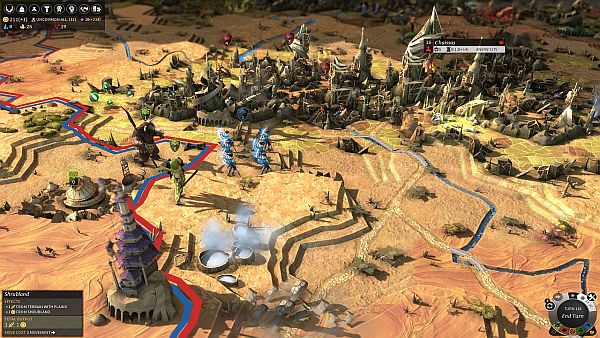
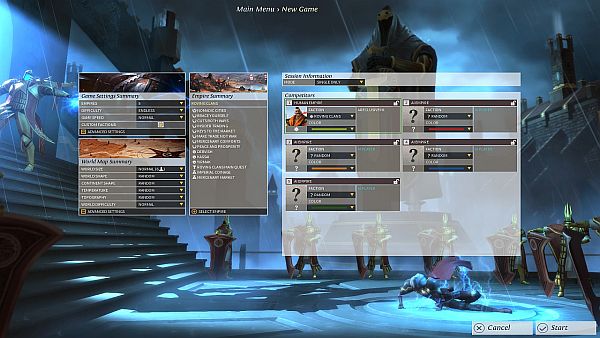
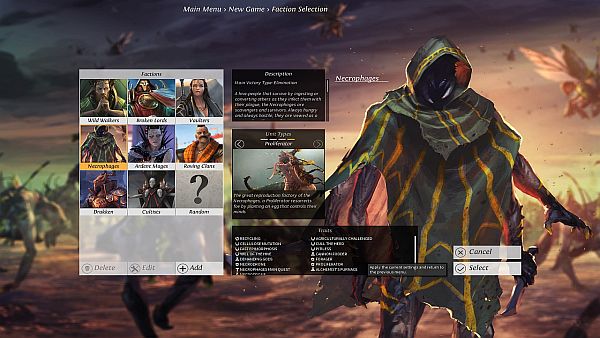
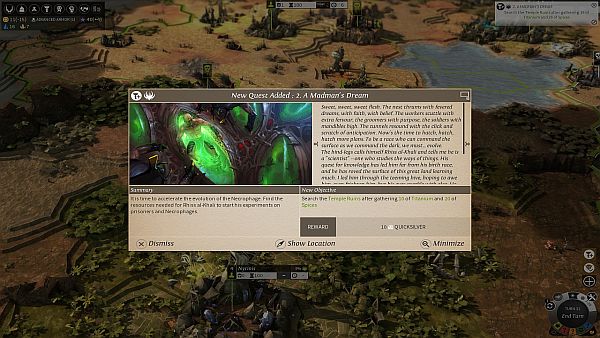
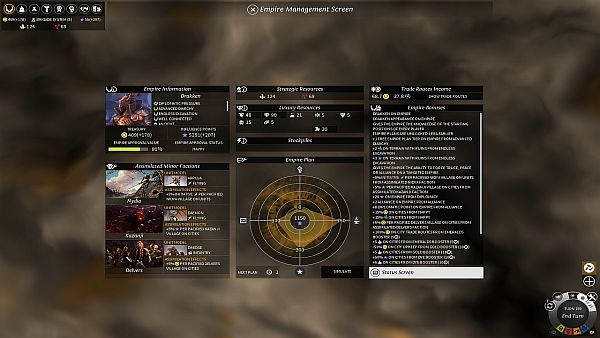
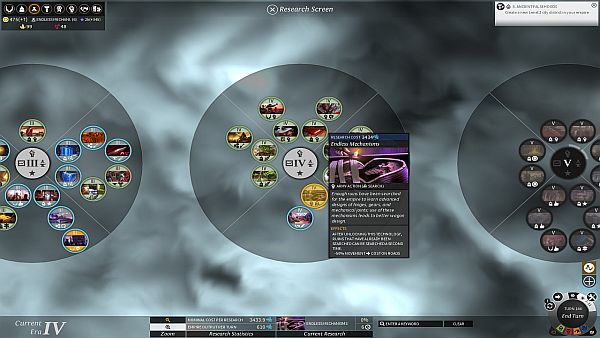
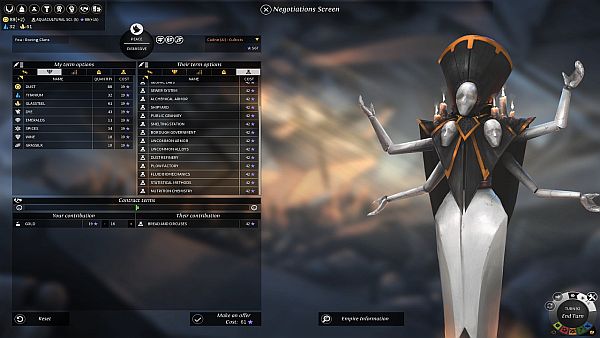
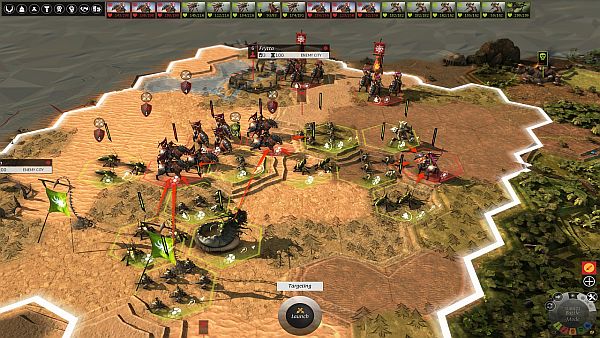
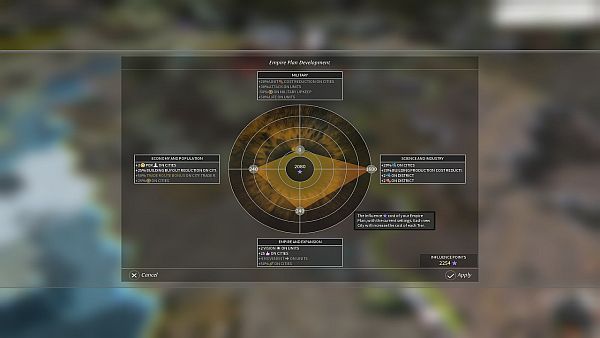
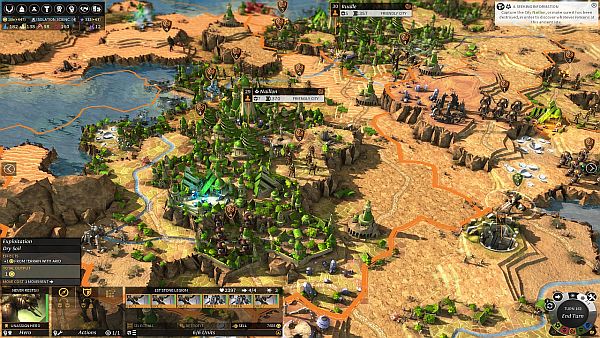

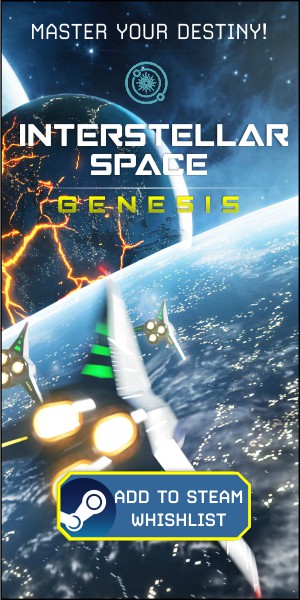
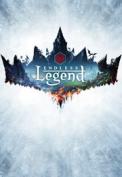




I gave it the same score with far less articulation. I completely agree with your sentiments and review.
I’m in love with this game and the expansions to come will only make it better. I’m so very glad to have an Amplitude Studios in this world.
Great. I’ll probably buy it soon then =) Or perhaps it’s better waiting for the first expansion. Too many good games are incoming at the moment. Anyways well done Amplitude! Hope you return to space in a year or so.
I hear ya man. Can you say Sid Meier’s Beyond Earth??? ;)
A very thorough and complete review! Thank you very much!
The most innovative feature of this game, and the one most game developers should emulate is the ‘Big UI’ option. This makes all the fonts, icons, etc, a decent size so they are easy to see and read.
Seriously, how many games have you looked at and said, ‘that’s a ridiculously cluttered and small UI, I would hate playing this game’. I tried playing Europa Universalis and it just gave me a colossal headache. This was with reading glasses on a 28″ screen.
This feature SHOULD BE LAUDED TO THE SKIES AND BE COPIED BY OTHER GAME DEVELOPERS.
While true :
1.) screen pixel angular resolution / eye angular resolution ratio can vary widely
2.) making multiple GUI’s requires effort
3.) even flat screens can in theory be adapted to run at specific fractions of their default resolution without blurriness issues (allowing black bars on the sides increases the range of available resolutions even further).
4.) While this might be seen a “new” feature, there are older game examples, for instance 1997 Dungeon Keeper. Also, some games have UI’s that either scale automatically (recent Blizzard games) or that allow you to resize various parts of the GUI yourself (Spring games).
While BlueTemplar has good points, I entirely agree. I have poor vision and difficulty reading most UIs. I have spent $30 on games that I simply cannot play due to the tiny fonts and miniscule icons and GUI. EU4 is one such example.
EL is playable, and even comfortable for me to play and that is saying something when most games are not.
Great review keith!
One problem i had when it was released was that the ai was not placing any or at least very little garrisson in their cities. Do you know if this has been fixed already?
Thanks for the kind words. I didn’t encounter that issue often as they generally had armies at least nearby (for instance in my last screenshot). It appears they have addressed this in the patch released late last week though:
“Fixed an issue where AI garrison does not keep more than one unit.”
Great review. I have been playing the game endlessly for weeks and totally agree with your conclusions. Just one complaint not mentioned is that I feel the happiness penalties for expansion are too severe. Why should your empire’s happiness go down if you capture an enemy’s city? When he attacked you first? And there’s not much you can do to improve happiness until the luxuries start building up. J
Haha, yeah that can start a serious luxury resource addiction problem.
I did have this issue with my Necrophage rush game, but I won before it mattered.
In other games I expanded slower and didn’t have as much of an issue. In some cases I had cities that were extremely happy. Perhaps they will tweak heroes so they provide some additional happiness when assigned to a city. Also I wouldn’t mind seeing a large stationed army having an impact on morale (increasing morale/productivity out of fear).
I played this 5 months ago, so alot is probably changed. At the time it didn’t have the same knife edge balance you feel when playing Deity Civ5.
I’m planning to pick it up again at some point and hoping this balance will have improved.
I’m surprised the AI came in the Pro column.
Did the latest patch fix things a bit? Amplitude forum has plenty of people complaining about the passivity of the AI, the lack of city defense and utter cake walk in the tactical. I saw a thread just yesterday saying how the latest patch made AI’s empire management even worse.
The reason I haven’t bought the game yet is the bad taste Warlock (the first one) left in my mouth. It was a very interesting game but the AI relies heavily on its bonuses to crush human players. Once you’ve adapted your tactic to hold off the initial spams, the complete lack of ‘I’ in AI became so obvious I couldn’t bare to play anymore; it did take me about 20hrs to reach that point mind you.
p.s. Did they update the flavour text in diplomacy to match the factions yet or does the bug still speaks with the same eloquence of the energy vampire?
I can only comment based on my own experiences. I have read many of the complaint threads and I often felt like I was playing a completely different game quite honestly. While it is possible some people are just much better than I am, the fact remains that the AI was very capable of winning by numerous means. I certainly can not say this for Warlock II which had awful AI, nor Age of Wonders 3 (at launch, still need to play Golden Realms + patches) which I was able to beat on the hardest difficulty without much trouble.
Cake walk tactical? Perhaps if you completely abuse high initiative archers armies. I have heard that complaint. It is easy to avoid though and still requires not being outnumbered heavily since you can only attack once per unit per round. It is true that the tactical AI makes non optimal moves at times, but this cuts both ways since it often ends up moving your units on its own mid turn as the situation changes. As I mentioned, it can be frustrating.
The city defense issue I responded to above. I can’t speak to the latest patch in regards to this or the diplomacy text that is generic for all factions (a disappointment, but fixable). My experience is that getting to the enemy’s cities can be difficult when they have superior level/tech armies reinforcing each other can be quite difficult.
Overall I lost to this AI multiple times. I could just be terrible at this particular game. However, there are other issues I saw mentioned in the forums that somehow I magically avoided over many hours or that are being exaggerated. I think some people will just never be satisfied with any title in this genre.
well, I think that the AI in EL is not better or worse than in other 4x games, though I’ve got the impression that it gets some kind of help as in my games it used to spam the map with settlers. The same thing with GC3 by the way: In my last game I observed an AI colonizing a planet in the same system I had established a colony a few turns earlier, and on the very next turn I saw a colonizer already produced on that AI planet which additionally had already a higher production output than my previous created colony. In this way, in just a few turns the AI managed to colonize all other planets in that system. So, giving massive bonuses to the AI seems to most developers to be the easiest way to make the AI somewhat competitive.
Keith, a terrific review … but it’s time as a community that we lift the bar on our expectations of the AI in 4X games. Whether the AI is challenging isn’t a sufficient criteria to judge the AI. Pump the bonuses up high enough, as Endless Legend does, and you’ll get a challenge … that does not mean the AI is good at all.
My experience with Endless difficulty was similar to yours and it was not fun. Either the AI would burn across the map / charge to a scientific victory that I could never reasonably hope to match (boring) or the game would be a cakewalk with too many passive AI’s (boring). The only way to win is a military campaign making it shallow. Impossible difficulty doesn’t sound any different fundamentally from your review.
The best setting for experienced 4X players that want a fun game is probably Serious difficulty. The bonuses are high enough to help the AI overcome a human player’s natural advantage without becoming ridiculous. This is the difficulty where the AI should be judged and I feel more games at this level were needed in the review to provide an assessment.
Prior to the most recent patch at Serious difficulty I was frustrated by the utter stupidity of the AI’s who left their cities essentially defenseless, amongst other problems. There are legitimate criticisms here about the AI around the forums. Any review of the AI should consider whether it passes the “mind-numbing stupidity” test. By this I mean any issue that can be picked up and resolved with testing and persistence … I’m not expecting an AI that can pass the Turing test here … just the obvious stuff.
Also the reason for some of the variation in forum posts was that the AI was actually broken on Endless Speed as the bonuses were incorrectly applied. I understand that has now been fixed. One has to wonder how a bug that significant got through testing if the AI had the priority it should have.
Now I haven’t played Serious yet in 1.08, because I’m choosing to wait until the AI is improved before playing again, and Beyond Earth is just around the corner, so interested in feedback on the changes.
I hope Zero is reading this for Stardrive 2 because at this point I can’t think of a better way to differentiate his product than to make the AI a genuine feature. And I look forward to seeing what Brad Wardell will do for GalCiv 3 next year.
I played it for a long time (>50 hours) in the beta last build and at the release and i would not recommend to buy it right now. Wait to see if the studio will improve the game.
Why do i say that?
– The game suffer for the same big, big problem i had with Endless Legend: it’s very, very shallow and repetitive. It’s managing to hide this a bit with nice background ideas and excellent graphics, but that’s all. You WILL spend your time filling buckets and emptying it, and managing an excel sheet (your cities). Like in a lot of 4X, would say some of you? Yeah, it’s partially true, but most of my preferred 4X succeeded to hide it a LOT better and to propose another internal ways of involving the player. Cities fail to really differentiate themselves. Regions are a good idea but badly implemented (so much potential wasted).
Minor Factions are just bonuses to unlock, yep, that’s all, a flat % of this or this.
The tech tree is not exciting at all: it’s piles after piles of mostly incremental bonuses to unlock, period.
– I’m all for innovation in games when it’s real innovation, not good ideas that fail to deliver their potential. With no spells, no terraforming, a very limited tech tree and city management, you will have see most of the game interest in 2 or 3 long games. i can’t comment on the multi-player part (which could be a better way to experience the game) because i didn’t have the opportunity to really test it until now.
– The AI is pretty basic, even on hard difficulties. Don’t expect anything fancy. It’s a bit game killing in the end.
– Some factions are wayyyyy more developed than others. The game feel a LOT rushed in this manner (the custom faction balance is a joke for the moment, sadly) and i think it was.
– But i repeat, the MAIN, BIG problem i have is the overwhelming feeling to manage a big and fancy excel sheet in the end. Add this number here. Substract here. New city. Build (most of) the same buildings you built everywhere. Rince and repeat. You win.
What is frustrating is the fact that you can feel the team was close to achieve something great, but the lack of time/vision/means, i don’t know, make the game strangely empty. Amplitude has top notch artists, devs, etc…but i don’t understand why they are not able to focus on the core: the gameplay, the way it feels to play the game, the mecanisms, the strategic depth.
If the studio is able to enhance the game to make it something more lively, more complex, more involving, maybe we could have a really good 4X here. I’m not sure that’s the way they have chosen. I can only hope. For now, i would advise to wait and see.
(Sorry for my mistakes in english, not my mother tongue :p ).
“I hope Zero is reading this for Stardrive 2 because at this point I can’t think of a better way to differentiate his product than to make the AI a genuine feature. And I look forward to seeing what Brad Wardell will do for GalCiv 3 next year.”
My name is Thrangar and I approve of this quote!
It’s less trying to make an AI that can pass the Turing Test and more how to design a game AI that behave in a way we human can recognise and enjoy playing against.
HOW the AI REACT to changes in the game (player or other AI input) is what defines a good game AI. Playing against an idiot human is no more fun than a idiot AI for example. Instead of trying to built a true AI, focus on how it reacts to key situations. For example, even hard coding the AI to leave X number of units in the city would give an illusion of intelligent play and mask the ineptness of the EL AI left to its own device.
Your comment is moot as there is no such thing as a “true AI”. What we have in games are “expert systems”, and “hard coding the AI to leave X number of units in the city” (and more complex variations of this) is AFAIK pretty much how “AI”s are done for complex games. As you say, it’s all about illusion of intelligent play, with the help of huge economic bonuses to compensate for lack of adaptability.
The sooner player stop excusing devs for creating awful AIs the sooner we can get some real progress done in this area.
I have the feeling that AI coder look at the daunting task of creating a true human-like AI opponent in games and just throw up their hands and give up. Instead of trying to do the impossible, they should try to find clever way to fool the players instead.
The original X-COM gave aliens greater vision range so a lot of combat is taken place away from players’ screen; many people ended up attributing random actions to actual strategies than made AI seem a lot capable than it actually is.
Endless Legend has issues that are nowadays sadly common to many video games :
– Bought trough a Steam key only.
– Downloaded and patched trough Steam only (AFAIK).
– Cannot be ran without Steam.
– Multiplayer is through Steam only :
— No LAN or TCP/IP
— No PBEM
— No Hotseat
The latter is linked to the choice of making EL a simultaneous turns only game which is also an issue :
– on one hand it causes not being able to directly control units during combat (as their orders are executed during a phase where none of the players can intervene)
– and on the other hand it causes the “quickest man wins” moves on the strategic level.
The speed of play of simultaneous turns and the fact you can finish a multiplayer game in one day far outweighs the cons. No player control during combat is also good because it would take way too long in multiplayer to be bearable.
Only if you’re willing to sacrifice the strategic/tactical aspect of the game for that… which is actually not mandatory depending on how you design the simultaneous turns part :
http://forums.amplitude-studios.com/showthread.php?27523-Forms-of-Multiplayer
Simultaneous does not necessarily mean that you can finish the game in one setting.
Example : SotS 1 and 2.
How did we play 4X games before connected-simultaneous (not PBEM-simultaneous) became the most common form of multiplayer?
Also, what I wanted to insist on, is that depending on design, nothing (besides additional coding effort) prevents a game to have BOTH simultaneous and sequential as choices. Example : Alpha Centauri.
Yeah I play civ 5 MP only simultaneous. so much better. And you can gang up on the lead player and get a small advantage through sheer clicking potential, which adds a fun layer to the diplomatic backstabbing!
I hear you man about Steam/Valve. These days I try to steer clear of them as much as possible (on ethical and moral grounds). Although Steam is easy to avoid when playing mmo’s, it becomes rather more problematic with single player games. It will be interesting to see though if I stick to my guns with the shortly to be released Steam-only Beyond Earth. Sighs.
Steam has improved a lot in the recent years… but some crucial issues are still left unaddressed (mostly about choosing which version of the game to play and not being able to play a game while a patch is being downloaded).
But exclusivity is bad in itself.
Thankfully, it seems that quite a lot of developers have decided to either release their game via multiple storefronts, and/or to minimize the invasiveness of DRM :
http://pcgamingwiki.com/wiki/The_Big_List_of_DRM-Free_Games_on_Steam
(It’s rather curious to have Counter-Strike : Source to be a part of this list, as not only a Valve game, it’s also mainly a multiplayer game.)
Note that technically, one might consider Steam itself to be DRM (because of account-linked Steam keys), but I fail to see how that is restricting anyone when the game folder itself can be just copied on a different computer without Steam.
Thank you Keith for the very thorough review. Endless Legend will definitely go on my wish-list for the next time I’m in the mood for a sword and sorcery 4X game. This looks to be the game that the mildly disappointing Age of Wonders 3 should have been.
FYI, agree with you all the way on what a big disappointment the dreary Endless Space was. I would not have even considered another game from Amplitude if not for your glowing review of EL.
BTW, surprised Ancient Space hasn’t been higher on Space Sector’s review priority list. I mean, it is after all a space game. ;)
It will come John, just hang on a little longer :)
Awesome review. Excellent work
I like how you just skipped the issue with pathing in combat almost entirely. That you pretend there’s actual tactical spells is also funny, all in all this review just screamed biased fanboy to me and I find it unfair to unadvised people trying to make a decision.
Go somewhere else and read more reviews if you want a more neutral review of this game.
Such as http://www.metacritic.com/game/pc/endless-legend?
Where 211 user ratings end up at 8.2/10, just as this review? Or the average of 30 game critics sites/journals come to the same rating?
This is one of the most extensive and fair reviews, laying out pros and cons in all detail. Your criticism is totally unjustified.
With regards to your statement about pretending there are spells: It is in the second paragraph of this article, boldly headlined with “Some words of caution”, that Keith writes “There’s virtually no spell casting in this game.”
Great review.
Purchased based on your review and to support Amplitude and the genre.
You guys seem to have the experience required to review these games in depth.
Let’s hope the developers address some of your concerns and continue to update this game with improved AI, more more unit and lategame diversity. Spells would also be nice :)
I can see it becoming a classic.
It would appear that as recent 4X releases go, Endless Legend appears to be the clear winner over Sid Meier’s Beyond Earth, if the Metacritic player comments and the general scuttlebutt in the forums is to be believed. Good to see Amplitude rebound from the decidedly weak Endless Space.
While this is probably true, when you consider user reviews, you have to remember that Civ:BE is automatically compared to Alpha Centauri.
Endless Legend doesn’t have the handicap of having to follow in the footsteps of a timeless classic.
I checked out Endless Legend… and I wasn’t impressed its gameplay. This looks to me like a rather polished version of the Stardock’s Elemental WoM original release. Cloth map, quests system, generic heroes etc. The resemblance is so close that you feel an amount of deja vu while playing it. It’s moot anyway. Games do plagiarize one another. What matters most is whether it will stand on it’s own feet. It does not, from my perspective.
Amplitude has a good knack for game atmosphere (i.e. aesthetically pleasing) from both its games, but I imo their game design philisophies/game designers fall short. Same issue faced with Elemental until they brought in the Fall From Heaven modder (who afaik is still there, I haven’t been keeping updates). Their latest Sorcerer King concept is intriguing, despite me not being a fan of Stardock (yes, really).
With Endless Legend you get this feeling that each an every step of the way, they over-streamlined stuffs that it virtually strips flavor from gameplay. Along the way, they added “alien” unproven concepts into the mix. The whole game plays like blandless generic, much like what Endless Space was. It’s like playing a *bleep* casual game from BigFish, not a fully fledged PC title. I have a hard time understanding players who raved about this game. I really do. To put in question, what are they raving mostly about? The game mechanics or the atmosphere? What if one was to strip away all that eye candy … is it still enjoyable to play?
I vowed to never touch anything from Amplitude after Endless Space. Ok, I lied. However after Endless Legend, I’ll be sticking it religiously.
Amplitude 4X games have great UI, interesting graphics and setting – completely cosmetic stuff of course but a lot of people aren’t good 4x players so some light challenge plus pretty picture is often enough to get a thumbs up.
Personally I know not to touch their stuff after ES and from what I can gather on the forum, I made the right choice hold off on EL.
I don’t understand how some people can be a fan of a company when they admit the AI (hugely important) is bad but will non-the-less support the devs because there’s a belief the devs will make things better down the road. I mean, if Amplitude is capable of making the AI better, wouldn’t it have done so in the first place instead?
Haters gonna hate.
Three wasted words that convey absolutely no info whatsoever.
Legit criticism helps a company to grow. Mindless fan boy/girl are just as bad as haters as they block off all other voices while not being profitable enough a group to sustain a company on they own.
Amplitude has its strength but it’s only a decent mid-tier dev in the 4X category. In my opinion, the lack of decent competition also inflates their current success atm.
Well, to me, with ES they had the benefit of the doubt. However with EL, all that disappeared.
It’s shaping to be a modus operandi for Amplitude. Make pretty games with avg or below avg gameplay for certain market segments. Just enough gameplay for it to be acceptable when coupled with polished UI and graphics with no major glaring flaws (AI although critical, can be made passable to create a semblance of play for the avg Joe masses). They managed to pull off what Horizon (L30) didn’t manage to pull off.
If they had any original passion for making a GOOD game, it’s been replaced with a jump into the bandwagon to churn out below avg games as fast possible (thus saturating the market) – as long as it brings in positive income. It makes a fairly sensible business sense but I don’t think they’re seriously weighing the long term impact that goes into intagibles like word of mouth reputation. The internet has long memories.
You know what would be interesting (that would exist only in someone’s imagination)? Getting them to loan out their UI dev(s) methodologies to folks like Kerberos or any indie oufits out there. That’s the only thing that I agree, they really excelled at. The rest are just poopworthy.
@SQW i @StormCloud
How long have you played the game and on what diffculties? Im a veteran player of 4x games (moo1 and2, sots 1 and 2, civ, and more) and i still had to play 2 lost game before i won on serious difficulty. On impossible i dont think I can win, and there is still one higher endless.
Your whole crtisism seems rather generic to me, and forgive me, but looks to me liek you didnt understand and more importantly didnt want to understand. Just critisice and feel so smart because of it. The amount of interesting and fresh mechanics in EL is impressive:
1-The races are nearly as different as SOTS, each plays tottaly different : Cultists with 1 city and conversion mechanics, Broken lords with pure dust economy and buying population on demand,Roving clans with moving cities, Necrophages with slavery…
2-The luxury resource boosters, scaling down with number of cities, meaning you got a way of keeping up with smaller empire.
3-Minorty factions that really are important, not some interesting but pointless feature like in most games.
4-The Summer/winter mechanic , again , for once it makes great ompact in gameplay.
5-Empire influence fuled plans.
6-The whole rpg aspect, different quest-stories for each race.
And saying about bandwagon and 4x games is imho a laugh, all of the failed 4x games are imho because
a)- Poeple were to ambtious
b)- inexpereinced people with to little resources tried to do it and were faced with harsh reality” it isnt as easy as it seeems”
Regardless you can try to bandwagon on browser games, or FPS, but nobody will choose 4x without a geniune passion for it.
Amplitude did a lot right in EL – the faction, art style, UI etc. However, the AI is still a simpleton to put it mildly and has made no visible progress since ES.
You said you are a veteran 4X player so you must realise the difficulties you face are not because the AI was playing intelligently but because the difficulty level gifts AI with huge, flat resource bonuses. If beating an idiot at chess is not fun, giving me a fatter idiot isn’t going to make the game more enjoyable. And no, just because every other 4x in recent memory failed miserably in this area is no reason why I can’t level the same criticism at EL.
I don’t expect a human like AI opponent but it absolutely kills my enjoyment of the game when my opponent does things that makes no sense again again for no benefit at all.
EL is 4X-lite. The visuals and mechanics are interesting enough for most people to enjoy a fantasy world but there’s little to make interacting with the other occupants meaningful.
I disagree on 4x lite firm statement, imho its a very deep game, did you read the few exampels of the mechanics i wrote?
Imho moo2 hasnt such deep mechanics.Come to think of it neither did Alpha Centauri.
I can understand not enjoying AI made difficult by bonuses, but its the reality atm. And for me if it makes the game hard, its good enough. I meanin my games so far the AI did all the basic stuff okay, like expansion, defense, buildign his armies, and fighting , and the bonuses makes it hard. Its good enough for me.Granted im a very combat oriented player, so diplomatic/trading AI i dont pay attentionso much
Ah been playing for a total of 47 hours and i still cant get enough, so “little” only becaus eim busy in rl, not playing anythign else. I also just start to realize the potential of some mechanics.
I have to say, as someone who hated endless space for its blandness, starlanes, and spreadsheet gameplay, I (like Keith) am pleased and surprised at how well this one turned out. I definitely prefer this to Beyond Earth, which the samey factions, one unit per tile, and late game unit and trade route micro is killing for me.
The art is beautiful, the setting is unique. It’s a polished and professional game with high production values. All of these things elevates the game above its peers to me just as a starting point. We can actually start the debate off on the merits of the strategy game rather than on the strength of its foundation. It’s a great place to be.
For me, personally, I always prefer to be in complete control of my combats. This is a primary area of difference between Zero Sum Games and Amplitude – the designers at Amplitude I believe feel very strongly that the player should not be getting their hands dirty with the nitty gritty of combat. They are the Emperor!
But to me it is the MOST important part of a 4x game. So while I am extremely impressed by Endless Legend, it’s lack of a true tactical combat does not sing to me.
In every other area of craftsmanship, Endless Legend is essentially a peerless success. They blew Civ: BE out of the water with their art direction and creating a compelling alien world. It’s such a pleasure to look at. The lore is rich. The strategic elements are fascinating in their own right.
So I think this is an effort to be celebrated. It’s not perfect (but seriously. What is? seriously). But it’s a very fine 4x and we want to encourage very fine 4xs even if they don’t scratch all of our individual itches.
If EL was Amplitude’s first outing then I’d applaud what they have accomplished. However, many of the crippling faults that were never addressed in ES (AI, overall game mechanic is too obvious an exercise in number shuffling) still exists in EL and that is why I’m more disappointed at EL than my purchase of ES.
Sure, the art direction and race diversity improved noticeable but I don’t play 4x games for artistic reasons; it’s almost like a top end graphic/design company is moonlighting as a game dev rather than the other way around.
Maybe third time lucky for Amplitude.
To be fair, by comparison CIV: BE is an appalling example in terms of game design progression and should rightful hang its head in shame in the face of EL.
I pretty much agree with Zero, Endless Legend is a great effort. I just wish the AI was a peerless success as well and had as much of a priority as other areas before release, so I could be immersed in the game for longer.